

![]()
What sort of lover of ice cream, roadtrips, and cows--albeit not necessarily in that order--could possibly have lived in Boston for 5 1/2 of the last nine years and not have yet gone to the Ben and Jerry's factory store in Vermont? Me, apparently. Here, for the record, is my digital collection of original cow pictures, with captions.
Anyway, thus inspired, we set out. A month earlier, while Robert was away for the weekend at a finance conference, I consulted books and websites and planned our route--in particular, Mapquest's trip-planning feature was really helpful. We chose the weekend of June 8th and 9th by process of elimination--it wasn't the conference weekend, or Mother's Day, or Memorial Day, or Father's Day, or the weekend I had to work at Harvard's Summer School orientation, or Noah's wedding weekend, and therefore, it was perfect. Incidentally, I noticed after our plans were all made that it was the weekend of my 5th-year Reunion at Wellesley, but as we had already decided to go to only the Friday Reunion events, that only seemed to start the weekend off on a more exciting note.
Saturday morning, June
8th, we were up and ready to leave at 8 a.m. In part, this was because we hadn’t
been able to find a non-metered parking space the night before. This meant we
had to rescue Norman from the meter maids who troll Harrison Blvd even before
8 a.m.
After a quick stop at Flour Bakery a block away for sticky buns and other nutritious
breakfast fare, we were on the road, driving straight north into New Hampshire.
![]()
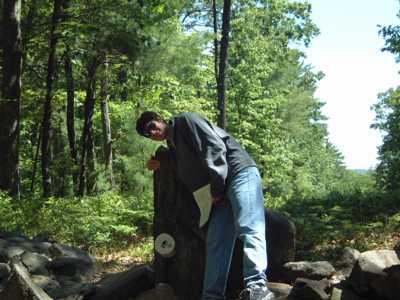 Just
past Canobie Lake in New Hampshire, we turned off the highway for our first
stop: the very grandly named America’s
Stonehenge. One guidebook I’d read had mentioned the place in
passing as a North American lithic site with standing stones in astronomical
formations, “slightly smaller in scale” than the British version.
That was all we knew about the place when we nearly drove past the winding driveway.
Turning around and entering, we found ourselves the only car in the parking
lot. At left, you see Robert hugging a standing stone (I think it was the spring
equinox one, but I can't remember).
Just
past Canobie Lake in New Hampshire, we turned off the highway for our first
stop: the very grandly named America’s
Stonehenge. One guidebook I’d read had mentioned the place in
passing as a North American lithic site with standing stones in astronomical
formations, “slightly smaller in scale” than the British version.
That was all we knew about the place when we nearly drove past the winding driveway.
Turning around and entering, we found ourselves the only car in the parking
lot. At left, you see Robert hugging a standing stone (I think it was the spring
equinox one, but I can't remember).
We walked up to the log cabin nestled in the woods and found a cheezy gift shop
full of crystals, candles, stuffed animals, tote bags, and socks. A woman at
the counter greeted us, and we paid the $12 apiece to tour the sight. “It’s
a self-guided tour,” she said, “with a ten-minute orientation movie.”
Robert asked when the movie was going to start, and she said it was starting
right now.
She ushered us into an adjoining room with standard motel conference room chairs
and a large TV/VCR at the front. She “started the movie”--that is,
she hit “play” and Robert and I giggled and chose center seats for
the show. Needless to say, there was no one else in the room. The video continued
the delightfully third-rate tone set by the gift shop: it featured a man named
something like Bob or Richard Stone talking about America’s stonehenge.
People kept tossing around the word “lithic,” and men in funny beards
came on the screen above little captions citing them as experts. We laughed
all the way through. Actually, we probably only laughed half the way through,
because we got up and left after five minutes.
It was a beautiful sunny day, though a little chilly--in sweatshirts and jeans,
though, we were 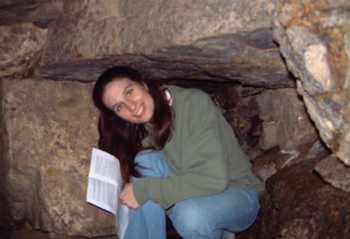 perfectly
comfortable, and we headed outdoors. We consulted our four-page fold-out practically
mimeographed maps, and started at the back door of the log cabin as told.
perfectly
comfortable, and we headed outdoors. We consulted our four-page fold-out practically
mimeographed maps, and started at the back door of the log cabin as told.
The map led us first
past an alpaca habitat. Alpacas, we learned, are the only natively domesticated
animal in the Americas. There were three alpacas, all adorable--kind of like
big, fuzzy, giraffe-sheep-cows. They made cute little Yoda-like noises with
their mouths closed and ate lots of leaves.
Past the alpacas, the trail was wide and well-marked, but still a little uneven--not
hiking, by any stretch of the imagination, but not quite a walk fit for grandmothers.
The first few stops along the way were unexciting--an old firepit, a well, an
old trash heap, the remains of a kiln next to natural clay deposits.
But, the site was completely deserted, though, and by the time we got to the
main part of the site--formerly called Mystery Hill--the woods and the atmosphere
(and the very realistic stings of the imported prehistoric mosquitos) had built
up, and prepared us somewhat for the very cool sight we saw: a big, rambling
series of stone caves, complete with drainage systems, meticulously built into
and out of rocks. Every chamber was labelled on our map with as much as was
known about its history, its probable lithic uses, and its date of construction
according to carbon-14 dating. Some parts of the site dated to 2000 B.C., which
is pretty amazing. In the eighteenth century a colonist built a house on top
of part of the site and used the chambers as basements and store rooms. Hey,
free basements. In the nineteenth century a stone quarry was built here, and
some of the stones were removed to make way for wagons and horses. Hey, free
stone. And in the twentieth century various people tried excavating the site
and reconstructing various parts of it--most of the ruins as we saw them, though,
were unreconstructed--left complete with the remains of the colonist’s
fireplace and the miners’ wagon-traces on top of the original stone structures.
Above right, you see Christina inside a completely dark chamber--I climbed in
blindly, posed blindly, and Robert snapped a picture blindly. The flash, needless
to say, helped a lot.
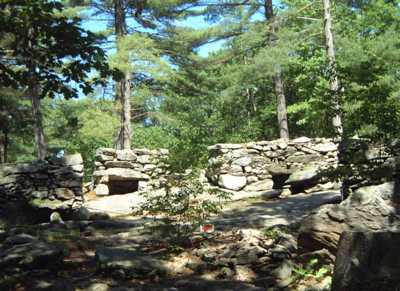 It was staggering
to think how old this all was, and that it’s just sitting out here in the
forest in New Hampshire--the site is privately owned, clearly not swimming in
funds, and isn’t even a National Historic Landmark or Monument or anything
like that. Nor is it like the Temple of Dendur in the Met--reconstructed, climate-controlled,
imported into a museum and plopped down, completely out of its natural environment,
and with plexiglass covering most of the interior walls. No, this place was
real. You could walk into the (very low-ceilinged and pitch-black) chambers,
lay down the floor of the Speaking Tube or the Oracle Chamber, with no tour
guides or museum guards to stop you. You could touch the walls and feel the
air cooler and mosquito-free inside and imagine the people who made them. You
could see the so-called Sacrifice Stone, analygous to the part of the actual
Stonehenge that Tess laid on, and you could climb to the top of a watch tower
built near the site in the 1920s, from which you could see every standing stone
in the distance, surrounding the main chambers, pointing to the points of the
moon and sun at Beltane and Midsummer and all the other important dates.
It was staggering
to think how old this all was, and that it’s just sitting out here in the
forest in New Hampshire--the site is privately owned, clearly not swimming in
funds, and isn’t even a National Historic Landmark or Monument or anything
like that. Nor is it like the Temple of Dendur in the Met--reconstructed, climate-controlled,
imported into a museum and plopped down, completely out of its natural environment,
and with plexiglass covering most of the interior walls. No, this place was
real. You could walk into the (very low-ceilinged and pitch-black) chambers,
lay down the floor of the Speaking Tube or the Oracle Chamber, with no tour
guides or museum guards to stop you. You could touch the walls and feel the
air cooler and mosquito-free inside and imagine the people who made them. You
could see the so-called Sacrifice Stone, analygous to the part of the actual
Stonehenge that Tess laid on, and you could climb to the top of a watch tower
built near the site in the 1920s, from which you could see every standing stone
in the distance, surrounding the main chambers, pointing to the points of the
moon and sun at Beltane and Midsummer and all the other important dates.
From the watchtower we walked a circuit around the main ruins to visit all the
standing stones, perfectly placed. These stones were somewhat small--only four
or so feet tall--and the path around them took us back to the alpacas and the
lodge.
We 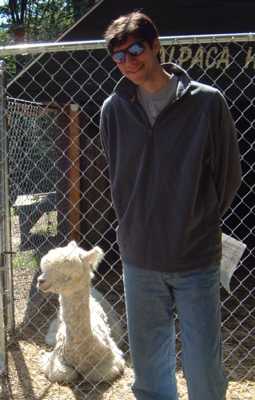 asked the
woman in the lodge why, exactly, the alpacas were there. She bristled a little,
though we hadn’t meant any offense (I was actually wondering if there was
historical evidence to believe that alpacas had actually lived at this site):
“We’re trying to broaden our appeal,” she said, “attract
more, different kinds of people.” She said the alpacas were very friendly
except when they were being shorn, which they didn’t really like, and that
her son fed them and played with them everyday. I imagined she was Mrs. Stone.
asked the
woman in the lodge why, exactly, the alpacas were there. She bristled a little,
though we hadn’t meant any offense (I was actually wondering if there was
historical evidence to believe that alpacas had actually lived at this site):
“We’re trying to broaden our appeal,” she said, “attract
more, different kinds of people.” She said the alpacas were very friendly
except when they were being shorn, which they didn’t really like, and that
her son fed them and played with them everyday. I imagined she was Mrs. Stone.
When we left, there were four or five cars at the site and a group of rowdy
frat boys teasing the alpacas. That’s broad appeal, all right. At right
you see Robert and a fluffy alpaca. Who's cuter, eh? Alpacas aside, I’d
tell anyone to take the one-hour drive from Boston and go there.
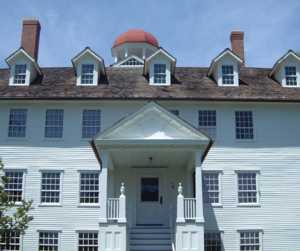 From
the Stonehenge we kept driving to Canterbury, New Hampshire, to a different
kind of historical place: the largest restored Shaker village in the country,
where the last living Old Covenant Shaker lived until she died in 1992. The
Shaker village is clearly very well-funded, with a brand-new visitors’
center and lots of different guided tours. We walked into a couple buildings
on our own, grabbed a sandwich, and then took a general tour. I hadn’t
known much about the Shakers before, but they immediately began sounding like
what we’d call some sort of crazy cult if they started up today. At left,
you see a Shaker building. Did you know they color-coded all their buildings?
Those crazy Shakers. . .
From
the Stonehenge we kept driving to Canterbury, New Hampshire, to a different
kind of historical place: the largest restored Shaker village in the country,
where the last living Old Covenant Shaker lived until she died in 1992. The
Shaker village is clearly very well-funded, with a brand-new visitors’
center and lots of different guided tours. We walked into a couple buildings
on our own, grabbed a sandwich, and then took a general tour. I hadn’t
known much about the Shakers before, but they immediately began sounding like
what we’d call some sort of crazy cult if they started up today. At left,
you see a Shaker building. Did you know they color-coded all their buildings?
Those crazy Shakers. . .
Our tourguide was practically
an eighteenth-century Shaker himself: he used “we” with alarming frequency
to denote the early Shakers and their great inventions (clothespins, rotating
oven racks, brooms, etc.). He also demonstrated Shaker dances and songs with
great enthusiasm, even attempting to get us to join in on easy ones, like the
rousing, “I’m glad I am a Shaker.” I was much more interested
in “Lord of the Dance,” which he only sang us one verse of at the
end and didn’t invite anyone to join in on.
After the tour we saw a woman spinning and another 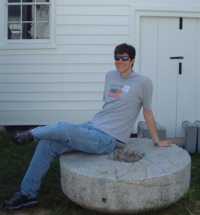 making
applesauce in a Shaker kitchen, and we heard more about the Shakers’ wonderful
inventions. Robert asked a few incomprehensible questions about patents, and
we wandered into the middle of a somewhat bizarrely placed Suzuki violin recital
in the chapel: twenty children under the age of ten, with varying sized violins,
attempting to play in unison or three-part harmony. It was not as bad as I’d
feared.
making
applesauce in a Shaker kitchen, and we heard more about the Shakers’ wonderful
inventions. Robert asked a few incomprehensible questions about patents, and
we wandered into the middle of a somewhat bizarrely placed Suzuki violin recital
in the chapel: twenty children under the age of ten, with varying sized violins,
attempting to play in unison or three-part harmony. It was not as bad as I’d
feared.
The whole village was
interesting and a different take, for me, on the classic restoration because
it wasn’t just your typical colonial or nineteenth-century village--not
just another mid-Atlantic maritime (Mystic) or New Amsterdam farming (Hudson
Valley) town. At right, you see Robert sitting on an old Shaker millstone.
After Canterbury we drove pretty much straight toward Vermont, diverging from
the interstates to take a state road instead, because our next destination--the
Fairlee Motel and Drive-in--was very much off the beaten path.
Briefly, along the way, we stopped at a New Hampshire tourist info place, trying
to find somewhere nice for a snack or early dinner. The heavy, toothless man in
the tourist info place was not helpful.
“Hi,” I said, smiling widely. “Do you know where we can get some
nice seafood? Clams, fish, lobster rolls?”
“Nope,” he said.
I stared.
“You’se far from the coast here,” he said, with practically a
Southern drawl. “Yer not on the coast no more, you know. There ain’t
no seafood here.”
Did the man realize that we were less than an hour from the Atlantic? We were
actually still in a coastal state, not entering the far west, un-oceany Vermont
for another hour. We certainly weren’t wandering around Iowa asking about
lobster, after all.
“Okay,” I said. “Is there anywhere really fun and exciting that
we just have to stop at?”
The man did not like that question. He glared at us. “You goin’ campin’?”
he asked.
“No,” I said, wondering where this was leading.
“Why you holding that, then?” he said, motioning at a brochure I’d
picked up from his desk.
I looked at the brochure. It said, “Camping, Dining, Fun.” I read
him the title. “Fun,” I repeated. “I took it for the ‘fun’
part.”
“That’s a camping guide,” he said.
I put down the brochure. We left, and got back on the road, deciding to wait
for dinner (and fun) until Fairlee.
![]()